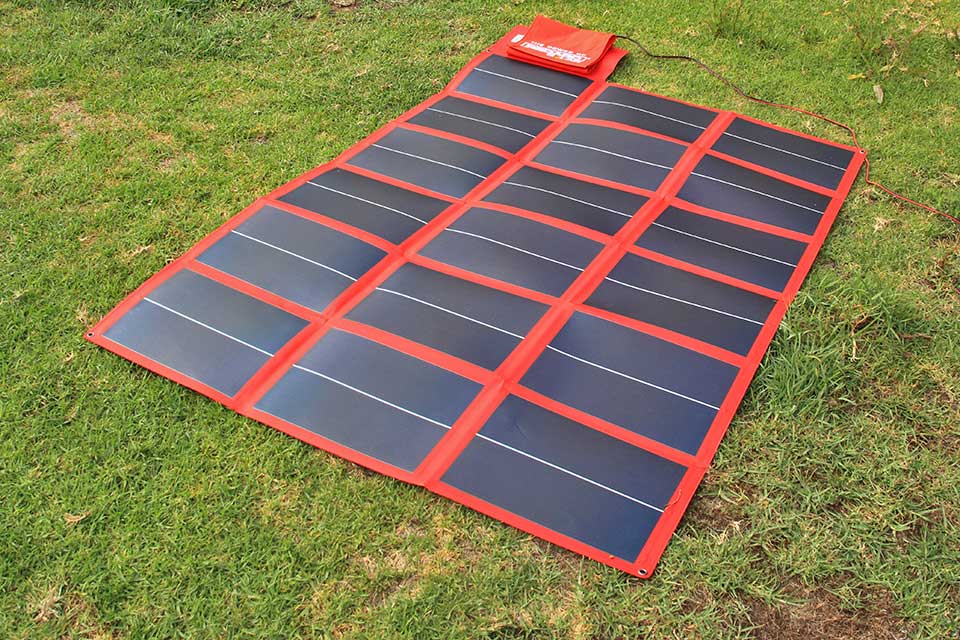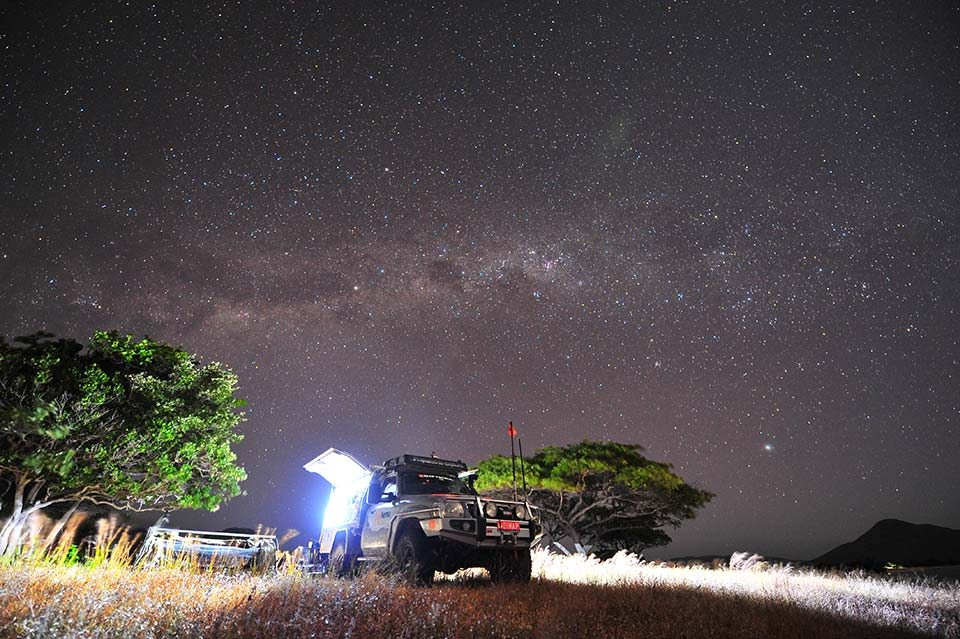Camping with Solar Power
Using solar power while you camp and tour off-road can seem like a dark art, but creating a reliable system that fits your needs is easier than you think.
Technical information for this article has been provided by REDARC Electronics, winner of Telstra's 2014 Business of the Year award for their innovative solar and electronic power solutions.
Is finding free and low-cost campsites & caravan parks is important to you?
Take a look at the Caravan & Camping Pack
The benefits of camping with solar power
Solar power is a clean form of energy that’s natural, renewable, and best of all free. Using an adequate portable solar system allows you to travel to unpowered and remote locations without sacrificing items like fridges, LED camping lights, mobile devices and more. Meanwhile, camping in these locations will generally mean you can avoid paying heftier fees for powered sites. Additionally, swapping a generator with some portable solar panels means you don’t have to detract from the peace and quiet you went outdoors to find (simply so you can power your fridge).
What you need to camp with solar power
A self-sufficient solar setup requires camping solar panels for compactness and portability, a solar regulator, a deep-cycle auxiliary battery and an inverter if you’re planning to charge 240v appliances such as a laptop or television. The way these products fit together is simple: solar panels gather power from the sun, which then flows into the battery via the solar regulator. Also known as a charge controller, solar regulators are important because they prevent damage to your battery from fluctuating charge or overcharging.
Solar panels come in different forms: mono-crystalline, poly-crystalline and thin film amorphous. Mono-crystalline panels are more expensive but also more efficient than poly-crystalline, meaning out of two panels the same size, a mono-crystalline solar panel will gather more solar power. Amorphous panels need greater surface area compared to mono and poly crystalline panels, though keep in mind the greatest asset of an amorphous panel is that is can be rolled or folded in the form of new-age solar blankets for compact storage when not in use. This isn’t the case with mono or poly crystalline panels, as they are fragile and thus require lamination to glass for adequate protection.
An example of a thin film amorphous solar panel that is foldable and durable, perfect for four-wheel driving and camping.

Deep-cycle batteries are the obvious choice for storing solar power, as they can be regularly and deeply discharged without harming the battery’s capacity to charge and store power. Keep in mind it’s ideal to limit your deep cycle battery’s discharge to around 70-50% of its capacity at a time to extend its lifespan, while discharging below 20% capacity will have a negative effect on its lifespan. Meanwhile, using power inverters for camping is a must for those who want to power their 240v AC appliances with the solar power they gather. Inverters change 12v DC (battery) power to 240v AC (household) power, with pure sine wave inverters (as opposed to modified sine wave inverters) the recommended choice for those who want power that is consistent and without spikes and surges; similar to a mains power supply. When buying a power inverter for camping, ensure the one you are looking to purchase produces enough power to adequately support the appliances you’re using.
Calculating your solar power requirements
Calculating your equipment’s power usage is key to creating a solar power system that’s tailored to you. Without a basic understanding of how much power your equipment is using, you could end up purchasing the incorrect battery, solar regulator or wrong-sized solar panel. If any one of these products is too small you could end up with a flat battery earlier than expected, or worse, a damaged solar regulator or battery. To calculate your usage, keep in mind most devices will have its power draw on the label that’s on the product, after which you need to work out how long per day you will operate the equipment to calculate it’s overall power draw.
Here’s an example of a basic setup: to run a medium-sized fridge that draws 4amps and some LED camping lights that draw 0.25amps each, a 120W folding solar panel kit coupled with a 100amp deep cycle battery and solar regulator would cover your needs and then some. To find out what products you require to fit your needs, check out Redarc's Solar Calculator.
How much power do solar panels gather?
How much power your panels gather depends on their size, how they’re used and the amount of sunlight hours in a day. To start off with, the biggest misconception of solar power is that ‘all sunlight is created equal’. While the output of a solar panel is dictated by sunlight, other factors including geographic location, ambient temperature and time of year have an influence over how much power is on offer for your solar panels to gather.
 Sunlight is standardised by the measurement of Peak Sun Hours, with this map highlighting the amount of sunlight Australia's varying regions receive on average per day.
Sunlight is standardised by the measurement of Peak Sun Hours, with this map highlighting the amount of sunlight Australia's varying regions receive on average per day.
In addition to location, solar panels have a slight loss in output performance above an ‘ambient’ temperature of 25 degrees Celsius, called the temperature coefficient, which accounts for a power reduction of -0.3% per degree Celsius. For these reasons, it always makes sense to overestimate your solar panel size when purchasing, which will account for unexpected or extreme weather, as well as when you’re staying in areas that have limited or interrupted sunlight. It’s important to note that amorphous thin film panels have less of a power loss from high temperatures, making their output more stable in high temperature regions compared to mono and poly crystalline panels.
These factors make it difficult to guarantee a pinpoint number that your solar panels will reap, though in general terms it’s safe to estimate that an 80W panel can supply between 4 and 5 Amps on a sunny day for most of the sunlight hours of the day (with an average of 8 sunlight hours in a day); for a 120W panel, this rises to between 6 to 7.5 Amps.
Mathematically, this would mean that a 120W panel system could supply 2.75 Amps continuously day and night running at no loss. In real world terms, this means that a 120W system linked to a 100Ah battery could supply power to a 50L fridge 24/7 and some camp lights for 6 hours a night for almost 5 days without any other form of charge. However, taking your battery’s need to keep a certain level of charge (to avoid damage to it), this number would settle at around 4 days off the grid when all is said and done.
What you should and shouldn’t power with solar
The most common equipment to power with a solar setup include 12v compressor fridges (which will account for upwards of 60% of your total power draw), camping lights, air compressors and inverters, which would then be responsible for charging 12v appliances such as laptops and televisions. When it comes to lighting, LED lights are preferable as their light patterns are highly focused and their power draw is minimal in comparison to fluorescent and halogen lights. Additionally, avoid powering major heating appliances like hair dryers from your power inverter, as these are energy-intensive and will waste your battery’s hard-earned power.
 Solar panels allow you to be self-sufficient in remote areas by powering things like 12v compressor fridges and LED camping lights.
Solar panels allow you to be self-sufficient in remote areas by powering things like 12v compressor fridges and LED camping lights.
Using solar panels while camping
Maximising your solar panel’s power gathering ability is an all-important mission for any camper or tourer using solar power. For tourers, roof-mounting flat solar panels on your camper trailer or caravan is ideal, as this allows you to gather power as you travel. Meanwhile for campers, a folding panel or compact thin film panel is the best option to save space.
Positioning and aligning your solar panel(s) is key to optimising its performance output as well, as panels that are perpendicular to the sun will capture the maximum amount of solar energy. Even a small angle of 10-20 degrees off perpendicular will allow sunlight to be reflected off the glass, reducing the amount of power that can be created. This means it’s important to align your panels according to the sun’s position in the sky when possible, as this small effort can greatly affect how much energy your panels will accrue.
The same goes for dust that gathers on solar panels, which obstructs sunlight and detracts from a panel’s performance. This is a greater problem for mounted panels, as they are constantly exposed and have to contend with any dust kicked up from travelling off-road. To remedy this, regularly wipe them down with a microfiber cloth, as using a more abrasive material will potentially scratch and damage a panel.
Understanding solar power terminology
The relationship between Watts, Volts and Amps can be confusing when misunderstood, though basically:
Watts (Power) = Volts x Amps
Watts, volts and amps form the basis of most solar power jargon, though on their own or even in a formula probably won't make much sense to most campers. To get a better understanding of what these terms mean and how they fit into your understanding of solar power, we can relate them to one another through a simple solar power analogy:
A Basic Solar Power Analogy
A basic way to understand solar power is to liken a solar setup to a rainwater system. The roof of a house that gathers the water is the solar panel, and the water tank is the battery. The greater the size of the roof, or the more watts a solar panel has, the more water that can be gathered. The water tank is pressurised and connected to a hose, with the water pressure representing voltage and the flow of water (or the water flowing) in the pipe attached to the tank representing amps.
Watts - the amount of power the solar panel is producing, with the total wattage of the panel only able to be achieved in perfect conditions, for example the solar panel at the ideal temperature and aligned with perfect sunlight.
Volts - the pressure of electricity being produced by the solar panel, similar to the height of water stored in a water tank: the higher the water tank from the ground, the more voltage and so more force for the water to flow.
Amps - the actual amount of electricity flowing in the solar panel and cables. We call this flow current, which can be compared to the amount of water flowing into and out of a water tank. The flow of electricity will vary depending on the amount of sun on our solar panel or if the battery is full or empty, large or small.
Amp-Hour (Ah) - the steady flow of 1 Amp for one hour, 5 Amp-hour (5Ah) is a flow of 5 amps for one hour.
Here’s an example of how Amps relate to Amp-Hours: a battery with a 1 amp-hour capacity should be able to supply a flow of 1 amp of current for one hour, 2 amps for half an hour and so on. A typical camping or auxiliary battery size is 100 Amp-Hour, and if our camping light has a rating of 1 amp we would expect our light to stay on for 100 hours.









0 comments